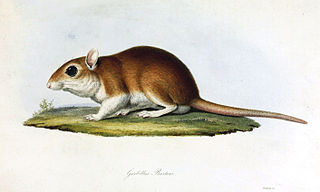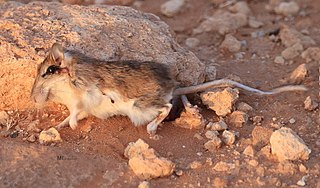Brockman's gerbil is distributed mainly in Somaliland and is only known from the type locality, Burao in central Somaliland.
Grobben's gerbil is a species of rodent, distributed mainly in Libya; Cyrenaica, Dernah. Less than 250 individuals of this species are thought to persist in the wild. It is named after Austrian biologist Karl Grobben.
The principal gerbil is a species of gerbil distributed mainly in Sudan; Jebel Meidob; El Malha. Fewer than 250 individuals of this species are thought to persist in the wild.

Waters's gerbil is distributed mainly in Sudan, Somalia, and Djibouti.
Harrison's gerbil is a gerbil, a small mammal in the rodent order. It is distributed mainly in the Tigris-Euphrates Valley in Iraq and western Iran. It is also known as the Mesopotamian gerbil.
The least gerbil is distributed mainly in South Sudan, southwestern Ethiopia, Kenya, and Tanzania.
The Darfur gerbil is distributed mainly in western Sudan.
The swarthy gerbil is distributed mainly in eastern Iran, southern Afghanistan, and western Pakistan.
Anderson's gerbil is a species of rodent distributed from Tunisia to Israel. Their habitats and diets are similar to other gerbils. The gestation period is 20–22 days and the average litter size is four or five. The IUCN formerly listed the junior synonym Gerbillus allenbyi as vulnerable.

Burton's gerbil is distributed mainly in Darfur, Sudan. Less than 250 individuals of this species of rodent are thought to persist in the wild. It may have been named after Edward Burton, who had the gerbil in his menagerie, obtained from Darfur and described by Frédéric Cuvier.
Flower's gerbil is a large gerbil distributed mainly in Egypt, from the eastern fringes of the Nile delta to the Sinai Peninsula, south of El Arish. Less than 250 individuals of this species are thought to persist in the wild, but it is not considered to be at threat, since it is common within its area of habitat and nothing poses a direct threat to it. This species is found in rocky desert, sandy coastal plains, grass valleys, palm tree groves and cultivated areas.

Tarabul's gerbil is a species of small rodent which is found in arid regions of north western Africa.
The western gerbil is distributed mainly in northern Morocco. It is listed as Endangered by the IUCN.
The cushioned gerbil is distributed mainly in Somalia, Ethiopia, Djibouti and Kenya.

The pale gerbil is endemic to Egypt and is distributed mainly in the northwestern part of the country. It is also known as the pallid gerbil. The pale gerbil has pale orange fur, with white underparts, white forelimbs and white feet. The ears are unpigmented and the soles of the feet are haired, which is a characteristic of sand-dwelling gerbils.
Lataste's gerbil is distributed mainly in Tunisia, Libya, and possibly Algeria. It is also known as the hairy-footed gerbil.
Hoogstraal's gerbil is distributed mainly in southwestern Morocco. There are thought to be less than 250 individuals in existence.
The Rosalinda gerbil is distributed mainly central Sudan.
The Agag gerbil is distributed mainly in southern Mauritania to northern Nigeria and Sudan. IUCN lists the junior synonyms Gerbillus cosensi and G. dalloni as critically endangered.
The Sudan gerbil is distributed mainly in central Sudan.




